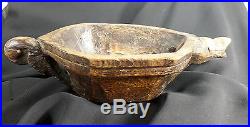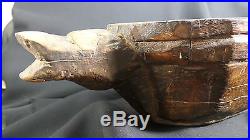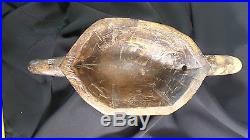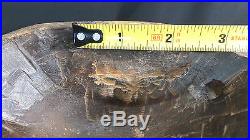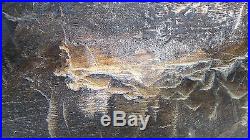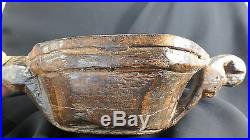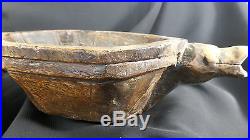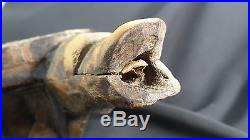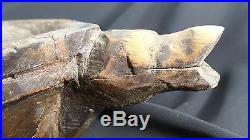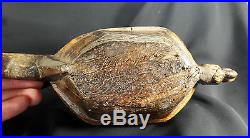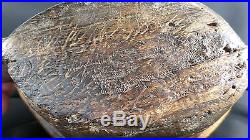X-RARE Northwest Coast RAVEN Effigy Burl Wood Mortar & Pestle! 1800s Suquamish WA
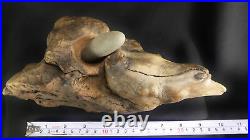
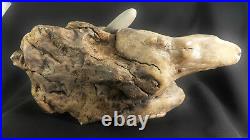
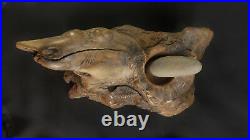
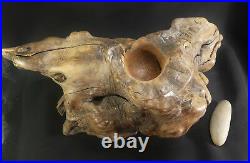
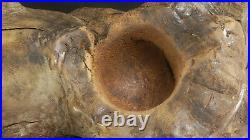
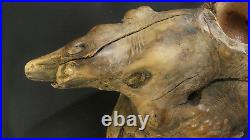
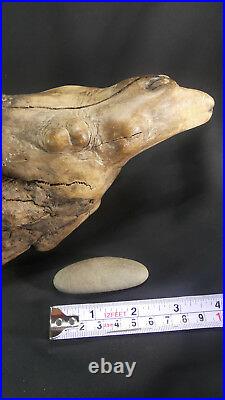
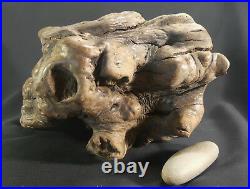
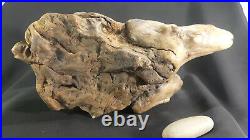
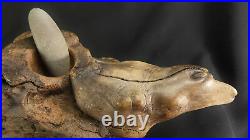
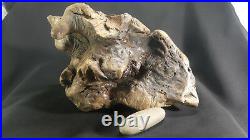
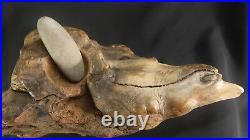

Ancient Art, Antiques, & Fine. Antique Native American Shamans. Raven Clan Effigy Burl Wood Mortar & Pestle. With Carved Pictographs Near the Center Bowl. Pacific Northwest Coast Native American. Suquamish Tribe/Puget Sound/Salish Sea. Collected on Bainbridge Island, WA. I certify that this antique Raven Mortar was reportedly found on private land on Bainbridge Island, WA, with the land owner’s permission in the 1800s. Held in a private collection in Seattle for over a century. Collection of any artifacts found on federal/state land or from caves, graves, or mounds is now strictly prohibited by federal law. NW Coast Suquamish Shamans Raven Effigy Mortar & Pestle. Material: Hand-carved, natural wooden burl branch. A burl is a natural, tree growth in which the grain and shape of the wooden trunk has grown in a deformed manner. Native Americans thought that these burls contained magical powers of healing. Find Location: Northwest Coast, USA, Bainbridge Island, WA, 19. Approximate Measurements of Wooden Mortar. 9.00 (22.5 cm). 4.00 (10.2 cm). 4.54 (11.5 cm). Weight: 1.75 lbs. Approximate Measurements of Small Stone Pestle. 2.27 (58 mm). This incredibly RARE Suquamish Shamans Wooden Mortar made from a wooden tree burl log that has the powerful Northwest Coast clan figure of a Raven carved into it. The Suquamish believed that animal figures like the Raven carved into objects made the bowl itself come alive with protective powers against evil spirits who were thought to dwell everywhere. The Trickster Raven was purposefully carved to protect and empower those who used this bowl from evil spirits. It is a very powerful and spiritual piece as it appears the Raven is in flight to carry the medicinal blessings to the sick or injured! This mortar would have been made, blessed, and used by only a single shaman for many years to make small batches of healing poultices for his patients. Native American from the NW coast thought that these burls contained living Spirits to help or harm humans and magical powers of healing. There are two (2) small pictographs (one is a 8.62 mm tall stick figure of a human–likely a depiction of the Shaman himself–and another figure that may be a Raven or other Spirit animal) carved into the top of the mortar between the Raven’s beak and the mortar’s bowl that measures about 1.34 or 34 mm in diameter! {You can see the small figures in macro photos 3-5}. Century mortar is rather crudely carved in style that was used among NW Coast tribes from about 17501850. And-carved mortar is made from a single wooden burl. While the small, stone pestle appears to be a water smoothed rock. NOTE: A burl is a natural, tree growth in which the grain and shape of the wooden trunk has grown in a deformed manner. Native Americans thought that these burls contained living Spirits and magical powers of healing and of protection. Very old examples of shaman paraphernalia are EXTREMELY RARE and only a few are known to exist in Native American museums and fine private collections. This fascinating, Shamans wooden mortar carved into the shape of The Trickster Raven came from a century old Pacific Northwestern collection of artifacts from the Puget Sound area on Bainbridge Island. The entire estate collection was obtained decades ago from the late Mrs. Henrietta Swansons relatives, whose family had early Seattle / island connections. Her descendants stated that the original collector had told Mrs. Swanson that their great grandfather acquired it in a trade on Bainbridge Island around the late 1890s. The style of carving and the patina of the wood suggests that it was made decades or perhaps a century before. This Raven Mortar effigy shows a closed-beak Raven at one end with a streamlined body as if in flight. The Raven mortar shows ware from ancient use by a tribal Shaman. The Raven was thought to scare away Evil Spirits and protect those around it. Minor dings, surface cracks, abrasion marks, grease/oil stains are consistent with age and heavy use over centuries. Deep chisel cuts are especially evident on the inside of the bowl. A very early and RARE wooden artifact from the pre-white settler indigenous population of the island/region. It is in Very Good to Excellent, Museum Quality condition and has a wonderful patina with no modern repairs or restorations. Museum quality with some loss of material to the Raven’s beak, minor cracks, abrasions, chips, and nicks that are consistent with age and ancient use. See macro photos for details. This incredible Suquamish hand-carved, mortar has the powerful clan figure of a Raven carved into it and two pictographs carved into the area around the center bowl. The Suquamish believed that animal figures like the Trickster Raven carved into objects made the mortar itself come alive with protective powers against evil spirits who were thought to dwell everywhere. The Raven was purposefully carved into the mortar to show the Raven protecting and empowering those who used this bowl to heal the ill and protect them from evil spirits and harm. It is a very powerful and spiritual piece that is museum quality! A Suquamish Shaman laboriously worked the large, native cedar burl into the elegant shape of a Raven into this incredible mortar. Totemic design of a Ravens head was carved into one end. This large burl is oblong shaped and very thick and robustly carved. Shaman in the Pacific NW were thought to communicate mystically and directly with he world of Spirits. This wooden mortar would have been made and blessed by a single shaman-priest and used throughout his lifetime. A Shamans artwork was his personal property and his regalia was potent and dangerous to others. Shaman were often transformed into spiritual animal helpers. Upon the death of a Shaman, his body and all his paraphernalia were buried far from the village as both he and his regalia remained highly potent and dangerous. Pacific NW Shaman were often buried in elevated grave houses and guarded by fierce grave figures. This mortar, with its small, circular bowl and relatively small pestle, would have been used for tiny batches of materialperhaps for making shamanistic poultices for healing/ritual ceremonies. Its small size rules out any food preparation useit is too tiny. The roughly hewed wood suggests this bowl was executed in a very early style, indicating a date of origin that could span from circa 1800 to well back into the eighteenth century. The broad, thick form-lines and deep, carved-out bowl are typical of objects that are documented to the last quarter of the eighteenth century, and many of those were undoubtedly created well before their documented date of collection by Euro-Americansin this case in the late 1800s. This archaic-style design work is usually attributed primarily to the Tlingit or Suquamish, and it’s very likely that this group was the original source of the bowl. However, in the very early historic period, northern Northwest Coast design styles had much more in common than they did in the mid-nineteenth century, after many decades of artistic evolution. Numerous examples of archaic-style objects collected from the Tlingit, Haida, and Suquamish exist to indicate that this style was common in their area in the early years of the contact period. The form-line designs on this bowl appear to represent the head of the eagle on the upper-beak end and the tail feathers and handle on the other end. This dual-representation or punning style of imagery is very common in the Northwest Coast tradition. The bowl is believed to be carved from Sitka spruce, a common forest tree on the northern Northwest Coast, but one that is almost never mentioned in the ethnographic literature as a carving material. Once one learns to recognize the appearance of this wood, however, it becomes apparent that there are a great many carved objects, many of them very early examples, that were carved of this material in the historic period. It was commonly used for bowls in the early contact period and before, as well as for war helmets, canoe paddles, and such works as combs and other small objects. Northwest Native American Raven Mythology. The Raven is a culture hero of the Northwest Coast and Alaskan Athabaskan tribes. He is a revered and benevolent transformer god who helps the people and shapes their world for them, but at the same time, he is also a trickster character and many Raven stories have to do with his frivolous or poorly thought out behavior getting him into trouble. In the mythology of many Northwest Indian tribes, Raven is honored as a culture hero. He is a revered and benevolent transformer figure who helps the people and shapes their world for them, but at the same time, he is also a trickster character and many Raven stories have to do with his frivolous or poorly thought out behavior causing trouble for him and the people around him. Raven is noted for negative traits such as gluttony, greed, and impatience as well as for his heroism and great deeds. Ravens are also used as clan animals in many Native American cultures, particularly those of the Northwest Coast (such as the Haida, Tlingit, Tsimshian, Kwakiutl, Nisgaa-Gitksan, and Salishan tribes) and the northern Athabaskan tribes such as the Tanaina. Raven is an important clan crest on the Northwest Coast and can often be found carved on totem poles, bentwood boxes, and other traditional northwestern art. In fact, the Haida tribe credits Raven for discovering the first humans who were hiding in a clam shell; he brought them berries and salmon. The Suquamish are a Lushootseed-speaking Native American people, located in present-day Washington in the United States. They are a southern Coast Salish people. Today, most Suquamish people are enrolled in the Suquamish Tribe, an indigenous nation and signatory to the Treaty of Point Elliott of 1855. The Suquamish traditionally lived on the western shores of Puget Sound, from Apple Tree Cove in the north to Gig Harbor in the south, including Bainbridge Island and Blake Island. They had villages throughout the region, the largest centered on Old Man House, the largest winter longhouse in the Salish Sea. Chief Seattle was an ancestral leader of the Suquamish Tribe who was born in 1786 at the Old-Man-House village in Suquamish. His father was Schweabe, a Suquamish Chief, and his was mother Scholitza, a Duwamish from a village near present Kent. Seattle was a six years old when Captain George Vancouver anchored in Suquamish waters off Bainbridge Island in 1792. The first contact between Suquamish and European peoples came in 1792 when George Vancouver explored Puget Sound and met members of the Suquamish Tribe, possibly including Schweabe and Kitsap. More regular contact with non-Natives came with the establishment of British trading posts in Puget Sound and the Strait of Georgia in the early 19th century England. Once the Washington Territory was established in 1853, the U. Government began signing treaties with area indigenous leaders to extinguish aboriginal claims and make land available for non-Native settlement. They reserved for themselves the land that became designated as the Port Madison Indian Reservation, near their winter village on Agate Pass. They also reserved the right to fish and harvest shellfish in their Usual and Accustomed Areas, and reserved certain cultural and natural resource rights within their historical territory. Today, the Suquamish Tribe is a co-manager with the State of Washington of the state’s salmon fishery. This is your chance to add an extremely RARE Shaman Burl Wood Raven Mortar to your collection! PROVENANCE: Chronology of Ownership. This authentic, Raven Effigy Mortar is from the estate of a prominent collector who lived in Bainbridge, Island, WA. I recently acquired it from a private collector in Colorado. This bowl will be accompanied by an ANCIENT CIVILIZATIONS Certificate of Authenticity at no additional charge. By the Editors of Time Life, 1992, pgs. Spirit Faces: Contemporary Masks of the Northwest Coast. By Gary Wyatt, 1998. The Coppers of the Northwest Coast Indians: Their Origin. Volume 79, Carol F. Understanding Northwest Coast Art: A Guide to Crests, Beings and Symbols. Each object I sell is professionally researched and compared with similar objects in the collections of the finest museums in the world. When in doubt, I have worked with dozens of subject matter experts to determine the condition and authenticity of numerous antiquities and antiques. All sales are Final, unless I have seriously misrepresented this item! Member of the Authentic Artifact Collectors Association (AACA) & the Archaeological Institute of America (AIA). The item “X-RARE Northwest Coast RAVEN Effigy Burl Wood Mortar & Pestle! 1800s Suquamish WA” is in sale since Friday, April 5, 2019. This item is in the category “Collectibles\Cultures & Ethnicities\Native American\ US\1800-1934\Other Nat. Am. Items 1800-1934″. The seller is “houghton-usa” and is located in Sequim, Washington. This item can be shipped to United States, Canada, United Kingdom.
- Modified Item: No
- Country/Region of Manufacture: United States
- Provenance: Ownership History Available
- Origin: Bainbridge Island, WA
- Tribal Affiliation: Suquamish

